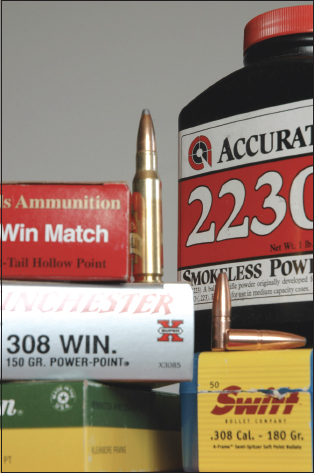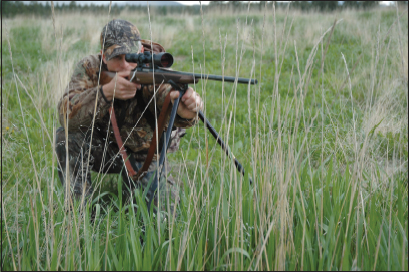9. Propellants from Cotton
Though most sportsmen know it as the traditional propellant for muzzle loading rifles and as the choice of purists in cartridge guns for Cowboy Action shooting, black powder still has military uses. It’s in the detonating charges for high energy propellants in artillery shells and propels ejection seats clear of aircraft. As in the nineteenth century, it still comprises sulfur, charcoal and saltpeter. They’re ground fine and mixed at 3 percent moisture. The powder “meal” is pressed into cakes, which are fed through a granulating machine where toothed cylinders chop them. After screening segregates particles by size, they’re polished in revolving wooden barrels. Most black powder is labeled A-1, Fg, Ffg, FFFg, FFFFg and FFFFFg, in decreasing order of granule size. Bigger grains generally burn slowest and work best pushing heavy balls or bullets. Very fine black powder is suitable only for priming charges and pyrotechnics.
Smokeless powder derives from different materials and processes. It starts out as nitrocellulose—vegetable fiber soaked in nitric and sulfuric acids. Guncotton, a special kind of nitrocellulose, has slightly higher nitrogen content (13.2 percent compared to a standard 12.6) and lower solubility in ether-alcohol solution. Like other forms of nitrocellulose in powder production, it comes from short crude cotton fibers or linters which are boiled in caustic soda to remove oils. Water formed during nitrating is absorbed by the sulfuric acid, thus preventing decomposition by hydrolysis. A centrifuge next strips excess acid; then the linters are rinsed and boiled 48 hours to remove all traces of acid which can cause spontaneous combustion. The cotton is beaten and boiled several more times. Agitators fluff it. The nitrocellulose is washed in solvent, then heated to evaporate the solvent. Hard grains of powder (and water) remain. “Cooking” the solvent off with heat applied to a wet solution is less dangerous than the old air-dry method. Ether is used to dissolve the fibers in nitrocellulose marked for single-base powders, acetone is used for double-base. Nitroglycerin is then added to form the double-base powder.
The soup at this point in smokeless powder production is unstable. More mixing turns the soup to a jelly, which is squeezed through dies (extruded) to form slender tubes of precise dimensions. Rollers push these tubes through a plate, where a whirling knife shears them into measured increments. The resulting grains of single-base powders still contain ether, so they’re sent to a warm solvent recovery room, where they soak in water for about two weeks. Wet single-base and freshly sheared double-base powders are then air-dried, sieved, and polished in drums that coat them with graphite. Tumbling smooths edges that might otherwise produce friction when the powder is jostled. Graphite further reduces friction while imparting the familiar slate color. Uncoated powder is yellow.

Accurate Arms powders serve a wide range of cartridges. The .308 Winchester likes several near mid-chart in burn rate.
In 1933 Western Cartridge Company came up with the first successful ball powder. Ball powder manufacture differs from the production of extruded powders, though the raw materials are essentially the same. Nitrocellulose intended for ball powders goes through a hammer mill that grinds it to a fine pumice. Blended with water and pumped in slurry form into a still, the nitrocellulose combines with chalk added to counteract the nitric acids. Ethyl acetate dissolves the nitrocellulose, producing a lacquer. Agitation and heat break the lacquer into small particles or it is pressed through plates much like extruded powders and chopped to bits by whirling knives. Tumbling and heating leave the grains round. When they’re of proper size and roundness, the ethyl acetate is distilled off and salt is added to draw out moisture. In a slurry of fresh water, the powder rushes through sizing screens. A heated still adds nitroglycerin. Burn deterrents come next, to smooth the pressure curve by controlling burn rate. A centrifuge removes excess water. The grains are tumbled in graphite then sized again. Some ball powders are measured blends of sizes. Some are purposefully rolled or crushed to manipulate burning characteristics. Ball powders meter better than most extruded or stick powders, and their manufacture is quicker and simpler.

Only about 30 percent of a cartridge’s energy pushes the bullet. About 40 percent is lost as exhaust; less than 1 percent reaches you as recoil.

Accuracy is a measure of consistency. New electronic powder measures like this one by RCBS ensure exact charge weights. The electronic trickler speeds up the operation.
Extruded powders are shaped like little tubes. The central hole controls the burn rate and pressure curve. Powders whose grain surface area diminishes during the burn are classified as degressive. Ball and flake powders are like this. Powders whose grain surface stays about the same throughout most of the burn cycle are said to be neutral. A one-hole extruded powder falls in this category because as flame eats away at the outer surface, it also consumes the grain from inside out. In the hole, burning increases surface area as the hole becomes bigger while flame on the outside reduces the grain’s diameter. At that final point of gas release, of course, grain size shrinks rapidly. Large powder grains may have multiple holes—typically 7 or 19—that help them burn progressively.
Progressive or neutral powders are intuitively the ones you’d choose for a sustained thrust, the big push needed to launch heavy, small-diameter bullets fighting lots of bore friction. But ball powders work in this arena too. That’s because additives throttle burn rate and gas release. Nearly all smokeless fuels have three additional components: a stabilizer to prevent decomposition of the nitrocellulose (commonly diphenylamine); graphite to make handling easier and increase electrical conductivity so static electricity doesn’t pose a threat; and a flame retardant to reduce muzzle flash (potassium sulfate is one). Additives are present in such small quantities as to have negligible effect on bullet velocity.
Single-base powders use only nitrocellulose to generate pressure; double-base powders have the added kick of nitroglycerine. That extra oomph makes double base powders a logical choice in cartridges of modest case capacity. VihtaVuori 500-series powders, for example, have up to 25 percent nitroglycerin to give them more energy than 100-series single base rifle powders that burn at equivalent rates.

Vihtavouri makes high-energy double-base powders in a range of burn rates. Handloaders esteem these Finnish fuels.
No matter what kind of powder you put in your handloads, or how much you pack into those hulls, expect only about a 30 percent return. That’s right: Only a quarter to a third of the energy released by the propellant actually pushes your bullet up the bore. About the same amount of energy is lost as internal heat during firing. Nearly 40 percent jets out the muzzle as hot (and useless) exhaust! By the way, only about .1 percent of the powder’s energy gets to you as felt recoil, which is good news. You wouldn’t want much more, even from the slowest powders in the least efficient cases.
Table of contents
- Title Page
- Dedication
- Copyright
- Acknowledgments
- Foreword
- CONTENTS
- INTRODUCTION
- SECTION I: BALLISTICS IN HISTORY
- SECTION II: THE MUSCLE BEHIND THE SHOT
- SECTION III: BULLETS—THE INSIDE STORY
- SECTION IV: SPEED, ENERGY, AND ARC
- SECTION V : PUTTING BALLISTICS TO WORK
- SECTION VI: FOR LONGER REACH
- BALLISTICS TABLES FOR MODERN SPORTING RIFLES
- GLOSSARY